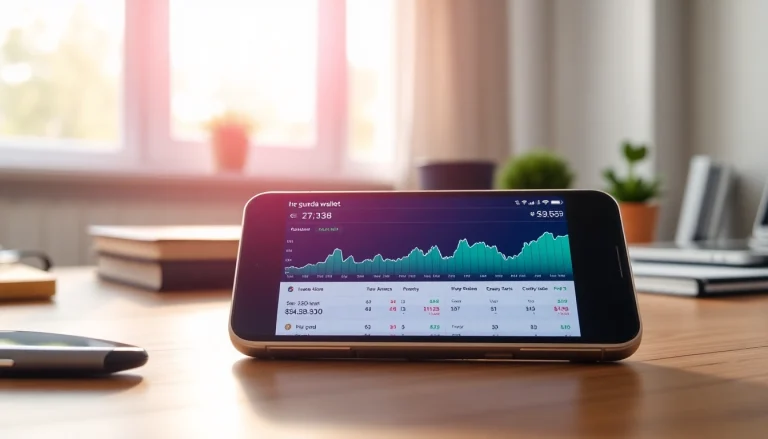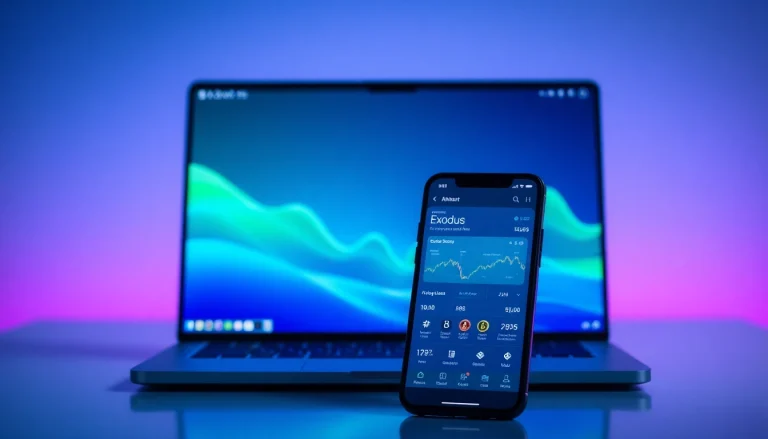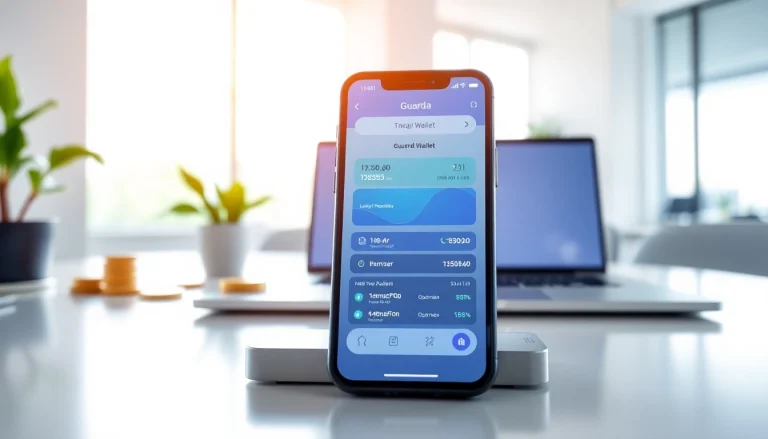
Understanding the Basics of Guarda Wallet
What is Guarda Wallet?
The guarda wallet is a non-custodial cryptocurrency wallet that provides users with a secure and user-friendly platform for managing digital assets. Designed to facilitate the storage, exchange, and transfer of various cryptocurrencies, Guarda Wallet empowers users by giving them complete control over their private keys. Unlike traditional wallets hosted by centralized exchanges, Guarda offers a decentralized alternative that enhances security and autonomy over one’s digital wealth.
Key Features of Guarda Wallet
Guarda Wallet comes equipped with a rich set of features geared toward enhancing the user experience. Some of the standout features include:
- Multi-Currency Support: The wallet supports a vast array of cryptocurrencies, accommodating Litecoin, Bitcoin, Ethereum, and many popular altcoins, making it suitable for diverse portfolios.
- User-Friendly Interface: The wallet is designed with an intuitive interface that caters to beginners and experienced users alike, simplifying complex transaction processes.
- Non-Custodial Nature: Users retain complete control over their private keys, ensuring their funds are not at risk due to third-party custody.
- Built-in Exchange: Guarda includes a feature that allows users to exchange cryptocurrencies directly within the wallet, adding convenience without the need for external platforms.
- Multi-Platform Availability: Whether on a desktop, mobile device, or as a web application, Guarda Wallet can be accessed across various devices, offering flexibility and accessibility.
Supported Cryptocurrencies in Guarda Wallet
One of the significant advantages of Guarda Wallet is its support for a wide variety of cryptocurrencies. Users can store and manage major coins like Bitcoin (BTC), Ethereum (ETH), and Tether (USDT), along with a myriad of altcoins spanning multiple blockchain networks. This extensive support makes Guarda an attractive option for traders and investors looking to manage diverse cryptocurrency assets in one place.
Setting Up Your Guarda Wallet
How to Create an Account with Guarda Wallet
Setting up a Guarda Wallet is a straightforward process that can be completed in a few simple steps:
- Download: First, download the Guarda Wallet application for your preferred device, whether it be mobile (iOS or Android) or desktop (Windows, Mac, or Linux).
- Create a Wallet: Launch the application and select the option to create a new wallet. Follow the prompts to set up a secure wallet.
- Backup Your Wallet: After creating your wallet, it is crucial to back it up. The app will provide you with a recovery phrase—store this safely, as it is essential for recovering your wallet in case of loss or device failure.
- Secure Access: Set up additional security features like two-factor authentication (2FA) or biometric access to enhance wallet security.
Best Practices for Securing Your Guarda Wallet
Even though Guarda Wallet offers robust security features, users should adhere to best practices to ensure their assets remain protected. Here are key guidelines:
- Backup Regularly: Always maintain a recent backup of your wallet’s recovery phrase. This will allow for quick recovery in the event of data loss.
- Enable Two-Factor Authentication: Utilize 2FA to add an extra layer of security beyond your password.
- Keep Software Updated: Ensure that you regularly update the Guarda Wallet app to benefit from the latest security enhancements and patches.
- Watch Out for Phishing Attacks: Be cautious when clicking on links and sharing sensitive information to avoid falling victim to phishing scams.
Mobile vs Desktop: Choosing Your Platform for Guarda Wallet
Guarda Wallet caters to both mobile and desktop users. Choosing the right platform largely depends on user preference and needs. Mobile wallets offer convenience for on-the-go transactions and quick access. On the other hand, desktop wallets provide a more extensive management interface, ideal for trading or managing larger portfolios. Ultimately, users may opt to use both platforms interchangeably, capitalizing on the unique advantages each offers.
Using Guarda Wallet for Everyday Transactions
Sending and Receiving Cryptocurrencies with Guarda Wallet
Using the Guarda Wallet for daily transactions is a seamless experience. Sending and receiving cryptocurrencies can be accomplished in just a few steps:
- To Send: Select the coin you wish to send, enter the recipient’s wallet address, specify the amount, and confirm the transaction. The app will provide details about the transaction fees before finalizing.
- To Receive: Navigate to the wallet interface, choose the cryptocurrency you want to receive, and share your wallet address or QR code with the sender.
Exchanging Coins: Step-by-Step Guide in Guarda Wallet
Exchanging cryptocurrencies within Guarda Wallet is simple due to its built-in exchange feature. Here’s how to perform an exchange:
- Open the Wallet: Access your Guarda Wallet and select the exchange option.
- Select Cryptocurrencies: Choose the cryptocurrencies you wish to exchange—one as the source and the other as the target.
- Enter Amount and Confirm: Specify the amount for the exchange. The app will show you the estimated result before you confirm the transaction.
- Complete the Exchange: Review the transaction details and complete the exchange. Your new currency will be credited to your wallet almost instantly.
Staking Options Available in Guarda Wallet
Staking is an investment strategy that allows users to earn rewards by holding certain cryptocurrencies in their Guarda Wallet. The wallet supports popular staking coins, enabling users to participate in blockchain networks that operate on Proof of Stake principles. To start staking:
- Select a Staking Coin: Choose a supported coin from your wallet that offers staking rewards.
- Lock Your Coins: Follow the wallet’s instructions to lock your coins for staking.
- Monitor Rewards: Track your staking rewards through the wallet interface, noting the accrued returns over time.
Security Features of Guarda Wallet
Understanding Non-Custodial Wallets: A Deep Dive into Guarda Wallet
As a non-custodial wallet, Guarda places security and control in the hands of users. This means users do not rely on a third party for storing their private keys. The implications of this design choice include:
- Enhanced Security: With no centralized storage of keys, the risk of hacking and theft from centralized exchanges is significantly minimized.
- Complete Ownership: Users have unconditional access to their funds and can conduct transactions without external approval.
- Greater Privacy: Non-custodial wallets often require less personal information compared to custodial solutions, bolstering user privacy.
Two-Factor Authentication and Other Security Measures in Guarda Wallet
Adding an extra layer of security is essential in today’s digital landscape. Guarda Wallet offers two-factor authentication (2FA) as a security measure that requires not only a password and username but also something that only the user has on hand, such as a physical device. Other security features include:
- Encryption: All user data is encrypted, providing a secure environment for transactions.
- Backup Options: Users are prompted to create a recovery phrase, allowing them to restore their wallet in case of device loss.
- Regular Security Audits: Guarda Wallet undergoes frequent audits to ensure compliance with the latest security standards.
Managing Private Keys Safely with Guarda Wallet
Private keys are crucial for the security of digital assets, and Guarda Wallet allows users to manage them safely. Here are effective strategies for managing private keys:
- Store Offline: Keep your private keys in a secure offline location, such as a hardware wallet, to protect them from online threats.
- Utilize Strong Passwords: Use complex and unique passwords to safeguard access to your wallet.
- Regularly Update Security Practices: Stay informed about the latest in wallet security and adjust your practices accordingly.
Comparative Analysis of Guarda Wallet with Other Wallets
Unique Selling Points of Guarda Wallet Compared to Competitors
While there are many cryptocurrency wallets available, Guarda stands out due to its combination of features and user-centric design. Key unique selling points include:
- Comprehensive Multi-Currency Support: Guarda supports a broader range of cryptocurrencies compared to many competitors, allowing users to manage all their assets in one place.
- Instant Exchange Features: The built-in exchange mechanism allows for rapid conversions without the need for third-party platforms.
- User Control: As a non-custodial wallet, Guarda Wallet ensures that users maintain control over their assets and private keys.
Customer Feedback and Reviews on Guarda Wallet
User feedback on Guarda Wallet has been predominantly positive, with many highlighting its ease of use and extensive support for cryptocurrencies. Common praises include:
- Simplicity: Users often note the wallet’s straightforward interface, making it accessible for beginners.
- Security: Many users appreciate the robust security features offered, along with the peace of mind that comes from non-custodial solutions.
- Comprehensive Support: Customer support and documentation provided by Guarda have also received positive remarks, helping users navigate the wallet effectively.
Future Developments: What’s Next for Guarda Wallet?
The future for Guarda Wallet looks promising with ongoing enhancements and plans for new features. Potential areas for growth include:
- Expanded Cryptocurrency Support: Continuously integrating new cryptocurrencies based on market demand.
- Enhanced User Experience: Focusing on improving the user interface based on feedback to make transactions even more intuitive.
- Integration with Decentralized Finance (DeFi): Providing more options for users to engage in DeFi activities directly through the wallet.




